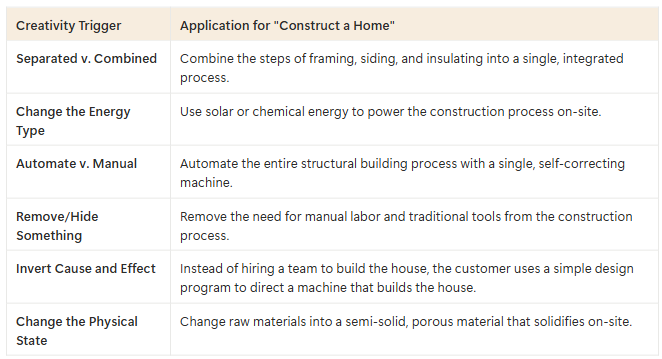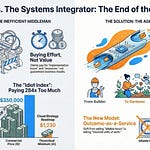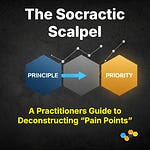I just reduced the price of my JTBD Masterclass for the final time. Get the tools that free you from consultants and analysis paralysis
Now, on with the show!
The buzz around artificial intelligence is everywhere. It’s the topic on your phone, in the news, and in every corporate meeting. Companies are pouring massive resources into AI, believing it's the answer to all their innovation prayers and the secret to a defensible competitive edge. But what if most of them are making the same fundamental mistake they always have? They’re getting caught up in the Shiny Object Syndrome, focusing on the solution, not the problem.
This isn't about dismissing AI. It’s about transforming the AI gold rush from a distracting, resource-draining fad into a powerful tool you can use to build a more predictable, profitable, and defensible innovation strategy. It all begins with changing your mindset.
The Shiny Object Syndrome: Why AI is an Innovation Trap
Think about the last major technology wave. The metaverse, crypto, big data. Each promised to be the next big thing, yet many companies failed to create lasting value for customers with them1. When businesses innovate for the sake of a technology, they’re engaging in what the Doblin framework calls
Product Performance innovation—making a better version of an existing product or adding new features. Research shows that this is often the easiest type of innovation for competitors to copy and provides the lowest return on investment.
This race to the bottom is the innovation trap at work. It’s the equivalent of building a "smart" circular saw with an AI-powered laser sight when a competitor is figuring out how to build a house without a saw at all. You're fighting for a tiny sliver of a mature market, all while a bigger, more disruptive opportunity passes you by.
The First Principle of Innovation: The Job
The most effective way out of this trap is to adopt a mindset based on Jobs-to-be-Done (JTBD). The core of JTBD is to approach innovation from a
First Principles perspective. It means letting go of assumptions and breaking down your customer's situation to its most fundamental truth: the "job" they are trying to get done. We say that people hire products and services to help them make progress in a given circumstance, and that job is at the heart of the strategy and innovation process.
A job isn't just a simple task; it’s a high-level goal that has functional, emotional, and social dimensions. The functional dimension is the practical task, like "get from point A to point B." The emotional dimension is how a person wants to feel while doing it ("feel safe"). The social dimension is how they want to be perceived by others ("be seen as eco-conscious"). By understanding all three, you can create a more valuable and differentiated solution.
To truly understand the job, we break it down into the eight steps of the universal
Job Map:
Define: The customer plans for the job.
Locate: They find the necessary resources and information.
Prepare: They set up the environment and make adjustments.
Confirm: They verify that everything is ready to go.
Execute: They perform the core task.
Monitor: They check to ensure the job is being done correctly.
Modify: They make adjustments or tweaks as needed.
Conclude: They finalize the job and wrap up.
Mapping the entire job reveals every point of friction and struggle, exposing opportunities for innovation that are invisible when you're only focused on a product.
Beyond the Tool: Elevating the Level of Abstraction
The single greatest danger of a solution-first approach is that it blinds you to truly disruptive opportunities. Consider a company that makes circular saws. Their market is mature, and they’re constantly fighting for market share. An inexperienced innovator might suggest a new feature. They’re focused on the "tool".
But what if you applied a jobs mindset? You’d ask, "What is the higher-level job a customer is trying to get done by cutting wood?" The answer isn't "cut wood." It could be, "construct a home". You see, by elevating the level of abstraction, you are no longer competing with other saw makers. You're competing with anyone who can help a person build a home.
In this expanded, higher-context market, what are the most painful struggles? Hiring contractors, managing labor, and the high cost and complexity of traditional construction. A company that focuses on this job might realize that a new solution could get the job done completely differently, better, and with fewer features. They might abandon the saw altogether and develop a novel concept like a 3D-printing technology that constructs an entire home on-site.
This is how you sidestep an entire industry and its established norms. It’s the difference between incremental innovation and true disruption. And it’s why understanding the job, not just the technology, is the only sustainable path to long-term success.
The Unified Moat: A Jobs-driven Strategy for Combining Doblin’s 10 Types of Innovation
Once you have identified the job to be done, you can use AI and other technologies as a tool to build a comprehensive competitive advantage across multiple dimensions. Doblin's 10 Types of Innovation framework provides the perfect blueprint for this.
Instead of just innovating on Product Performance (an easily copied AI feature), you can use the job to inform more defensible types of innovation:
Process Innovation: Use AI to automate internal processes that are a part of the customer's job. A financial firm could use an AI to automate complex analysis, reducing the time it takes for a customer to
monitortheir portfolio and make adjustments. The result? A new, superior process that makes the customer’s job faster.Network Innovation: If a customer’s job requires coordination with multiple people, you could use AI to create a new network that gets the job done seamlessly. An AI-driven platform could intelligently link a patient to the right specialist at the right time, getting the job done better and with less hassle.
Service Innovation: Identify the painful steps in the job and build a service to help. An AI assistant could provide real-time guidance on a complex task like "installing a new product," reducing the effort required to complete the
prepareandexecutesteps of the job.Channel Innovation: If the job needs to be done on the go, a voice-activated AI or an on-demand service could create a new channel to deliver the solution to the customer. This is exactly how companies can leverage new technologies to get the entire job done on a single platform or via a single offering.
By combining multiple types of innovation, you create a holistic solution that’s almost impossible to copy. It's a strategy that builds a genuine competitive moat, not a flimsy fence of features.
Conclusion
We’re at a crossroads. We can continue to get caught up in the latest technological fads, or we can choose a different path—one that is proven to create value and drive growth. The future isn't about the technology; it’s about a relentless, systematic focus on the customer’s job. AI is a powerful tool, but it's not the goal. The companies that will win are those that master frameworks like Jobs-to-be-Done and Doblin’s 10 Types to find and solve real, meaningful problems, using technology to get the job done better.
Follow me on 𝕏: https://x.com/mikeboysen
If you'd like to see how I apply a higher level of abstraction to the front-end of innovation, please reach out. My availability is limited.
Mike Boysen - www.pjtbd.com
Why fail fast when you can succeed the first time?
Masterclass: https://pjtbd.com/mc
My Blog: https://jtbd.one
📆 Book an appointment: https://pjtbd.com/book-mike
Join our community: https://pjtbd.com/join












